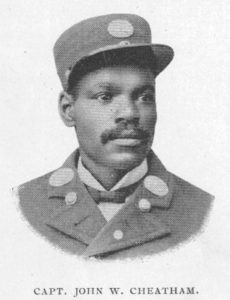
John Cheatham
*John Cheatham was born on this date in 1855. He was a Black Pullman Porter and Minnesota Fireman.
Born into slavery in St. Louis, Missouri, he was freed on January 1, 1863, when the Emancipation Proclamation went into effect. Shortly afterward, his family moved to Minneapolis, where he attended school. After graduation, he held several jobs, including porter and church sexton.
On March 13, 1888, Cheatham was one of 37 men appointed to the Minneapolis Fire Department by Frank L. Stetson, Chief Engineer. Although the records aren’t entirely clear, Cheatham was, if not the first Black firefighter in Minneapolis, certainly one of the earliest. He had a distinguished career within the department, holding several positions and receiving numerous promotions. He began as a pipe man and was promoted to driver after three years. Less than three years later, he was promoted to lieutenant. On January 1, 1899, he was promoted to captain.
Cheatham and his wife, Susie, owned a home at 3020 20th Avenue. Their four children, Ethel, Bertha, Gilbert, and Wesley, attended South High School, and the family belonged to Bethesda Baptist Church. On June 16, 1906, Susie Cheatham died from typhoid. Within a year of her death, John Cheatham found himself at the center of one controversy in his career.
In 1907, Cheatham and two other Black firefighters (Lafayette Mason and Frank Harris) were in charge of the Minnehaha Fire Station #24 at 45th Street and Hiawatha Avenue. Their appointment met with resistance from some residents who circulated a petition demanding that white firefighters on “general principle replace the men.” That was “strenuously resisted” by another group of residents who circulated a petition supporting the firefighters.
An article in the Minneapolis Journal detailed the excellent records of Cheatham, Mason, and Harris. The article noted that Cheatham had “distinguished himself” in the House of the Good Shepherd fire and said, "no man on the books of the department who can show a better record.” Cheatham said he wanted “a chance to educate my children and get them started right.” He described the move to replace him as “drawing the color line and drawing it stiff.” His supporters were successful, and John Cheatham remained at the Minnehaha Fire Station until his retirement. He died on August 15, 1918, from chronic endocarditis at 63. He is buried next to his wife and his daughter, Ethel.